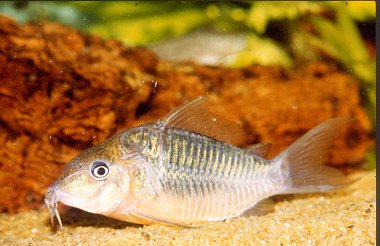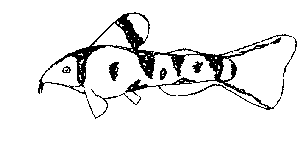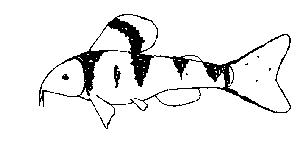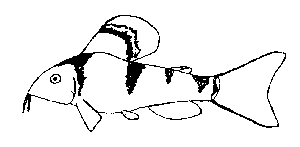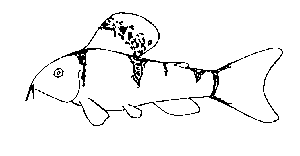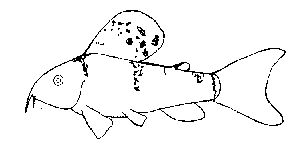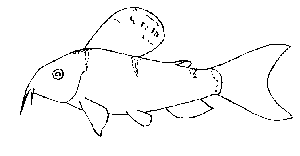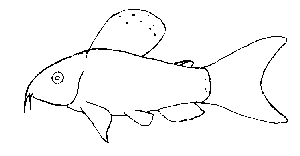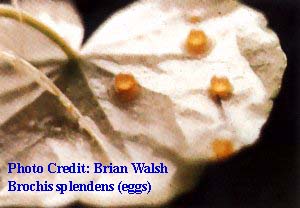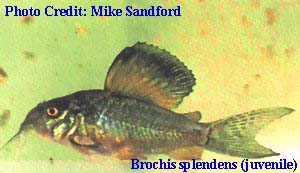SCOTCAT.COM
your internet guide to all things catfish
| Breeding and Development of Brochis splendens (Castelnau, 1855) |
by Brian Walsh |
Brochis splendens
Six months later a supposedly new high-fin Cory appeared in the dealers. They had green and black speckled bodies with orange, white and black blotched dorsals. All were very small, about 2cm. On examination of the dorsal rays they were found to be a Brochis species. 1 bought 10 of these very young Brochis and placed them in quarantine. Three weeks later they were placed in the 6 foot tank alongside the other Brochis. By this time their colours had changed quite dramatically. They had lost all the orange, white and black and had become metallic green, just like my original stock of Brochis. All the fish continued to grow well and lived together with no problems. None of the Brochis showed any signs of spawning activity even though many of the Corydoras species 1 had in that tank spawned frequently. Over the next few years the fish continued to grow. I had lost 5 of the original 7 wild caught fish. The remaining 2 had been the smallest of the batch but had now grown on to just under 7cm and were obviously mature fish. Of the hi-fin types, 1 had lost 5 and the remaining 5 fish had grown to about 5cm and then stopped growing. New
tanks for old. After the next 5 days the tank was checked morning and night for any spawning activity. On the morning of December 17th the smaller fish were again seen chasing and nudging the larger fish. When I returned home from work that night and looked in the tank, the female was noticeably thinner. On looking carefully through the tank, eggs could be seen stuck to the back glass, all were within 3 inches of the surface and very few had been placed on the plants. The temperature was 74'F and the pH 6.5. The eggs were carefully removed using a Stanley Knife blade and transferred to a smaller tank, 18 inches by 6 inches by 6 inches, to hatch. The eggs were light yellow in colour but changed to orange, then light brown and finally became darkly mottled just before hatching. At 74'F the eggs took 4 days to hatch. On hatching the fry measured approximately 7mm in length including the tail and had a very small yolk sac. Of the 150 eggs collected from the tank only just over 100 hatched. The fry were darkly mottled and accepted Brine Shrimp on the second day after hatching. They grew well and on the, 5th day 1introduced microworms to their diet. By the 12th day they were eating chopped up Tubifex worms and had grown to 17mm. By now their fins had fully developed, the dorsals becoming very large and strikingly coloured with an intense white edge. The fish grew on well and at 30 days old were 23mm long and looked just like the hi-fin Corys 1 had bought several years earlier. Late to bed... Fourteen days after the first spawning the Brochis spawned again. This time they spawned at night. I managed to witness and photograph much of the preliminary spawning activity. The colours on the males and female became more intense and black reticulated markings became visible on all the fish. At this time the colour pattern closely resembled that of Corydoras sodalis. Unfortunately, they still had not started to spawn at 1.30a.m. and, as 1 had to go to work the next day, 1 retired to bed....early to rise. First thing that morning, at approximately 6.00a.m., 1 went into the fishroom just in time to take a slide of their last spawning run. All the eggs had been placed on the undersides of floating plants and none on the tank sides. Again, the eggs were removed to hatch in a tank on their own. Of approximately 120 eggs collected only 42 hatched. Four nights after the fry had emerged from the eggs we had quite a severe frost in our area and the temperature dropped quite suddenly by approximately 5 degrees in the fishroom and the following morning 26 of the 42 fry had died. In subsequent spawnings I placed a small heater and outside stat on the tank to alleviate this problem. To date, the trio of fish have spawned 12 times and every spawning since the first has taken place at night in total darkness. The number of eggs hatched has never been greater than 50 and more often than not has been around the 30 mark. Placing low wattage bulbs over the tank and leaving them on when the fish showed some spawning activity only resulted in the fish losing interest completely. The fish spawned regularly from the 17th December until the end of May and have not spawned since. This, I believe, could be be the end of their spawning cycle. Many of the catfish that we keep have this in built spawning calendar that, out in their natural environment, allows them to produce large amounts of offspring when there is an abundance of food available for the young to grow on. It also gives the adults a rest period and a time to recuperate ready for the next cycle.
4th
day: approximately
11mm; dorsal beginning to extend and get a white
tip: adipose, caudal and anal fins beginning to
be formed; body markings reduced.
6th
day: approximately
14mm; dorsal still growing, getting a white edge;
body markings reduced.
8th
day: approximately
15mm; dorsal still growing, black and white stripes
very prominent; fins fully formed; body beginning
12th
day: approximately
16mm; dorsal still growing, black stripe beginning
to break up, white edge showing an orange cast to
it; body still deepening.
25th
day: approximately
23mm; dorsal at full height, orange and black mottled
with a few white patches remaining; body deep, metalic
green with black speckles.
30th day: approximately 27mm; dorsal losing colour; body colour deepening and losing black speckles.
43rd day: approximately 32mm; dorsal almost clear; body colour metalic green with no black present.
Plants, rocks and wood allow Brochis to choose its preferred spawning site.
The transformation
between juvenile and adult B.splendens is
dramatic.
This article was
originally in the Catfish Association of Great Britain's
magazine no.66, 1990.
Photo Credits:
|
If you would like to contribute an article, please e-mail me. You will of course be credited for your work.
If you would like to donate any denomination of money to the site just click the above link button. All proceeds will go to running the site and hopefully to keep it going for a few years yet.
Print or e-mail this factsheet below
